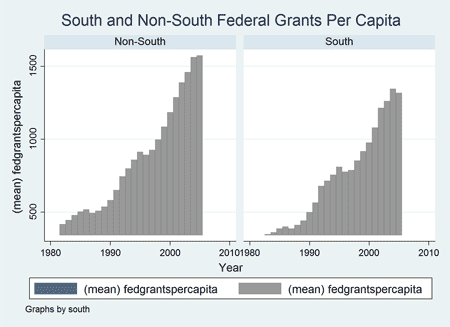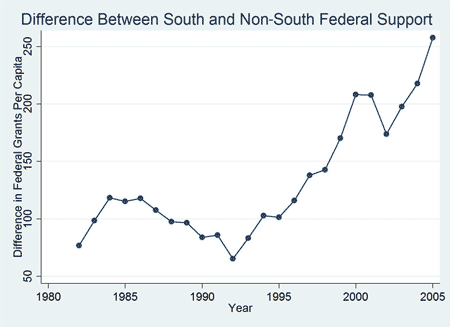Throughout most of the history of the United States, the South has been a pivotal region in national politics. Accommodations were made to the South in the writing of the Constitution, the westward expansion of the United States, even after the Civil War that ostensibly settled the issue of national sovereignty (in the Union’s favor). In the twentieth century, Pork barrel spending was lavished upon the South because it has been the conventional wisdom that control of the Federal Government could not be won without the states of the old Confederacy. And, yet, in 2008 Barack Obama managed to win the presidency without the South.1 After trying for years to accommodate the South, the Democrats finally gave up and followed a plan to sidestep southern politics. While they did suffer substantial setbacks in the midterm elections of 2010 the Democrats have found a formula for ignoring the South. The question then is; does the South with its relatively monochromatic red state politics, run the risk of becoming a backwater in the American political game? Will it be ignored by Democrats who don’t need it and Republicans who can take it for granted?
In this paper I will make the argument that the South runs the very real risk of becoming irrelevant to American national politics, the consequences of which can be devastating to what is one of the poorest regions in the country. While it may be a good or bad thing, depending on one’s position along the political spectrum, whether or not the South can influence social and political issues, some of our most vulnerable citizens live in the South, in what are low tax, low service states. Without the intervention of the Federal government, the South runs the risk of becoming a country within a country, a third world state with dramatic disparities in the standard of living for the rich and the poor, nonexistent consumer protection, a crumbling infrastructure, and inadequate public schools and health care.
The Federal response to hurricane Katrina is a case in point. Lack of coordination at the time of the disaster, partisan politics at the state and national level, and a lack of follow through after the water had gone permanently scattered many of New Orleans disadvantaged residents (mainly residents of the poor Ninth Ward) to the winds. The city is permanently scarred and like the rest of the South, it is possible that New Orleans will never completely recover.
The response to Katrina is a metaphor for the South. In areas that could be commercially redeveloped, Katrina provided an unexpected opportunity for urban renewal. The lovely old homes that lined the Mississippi coast were flattened to be replaced with condos and casinos. But in New Orleans, there is no economic value in the old Ninth Ward; there isn’t even enough economic incentive to tear down the ruined wood framed houses that still stand there in mute testimony to a disaster that struck over six years ago.
 Fig. 1. The Lower Ninth Ward 2010.
Fig. 1. The Lower Ninth Ward 2010.
Published by permission of the photographer, Douglas Lang.
For the South in the past, unity was strength. But the current red state composition of the South puts the region at risk of being ignored. How did it get this way and what, if anything can be done? In the aftermath of the beating it took at the hands of the Democrats in 2008, and hurricane Katrina before that, the political standing of the South is at as great a risk today as it was at the end of the Civil War. The question was then as it is now, will the South rise again?
Structural Advantage for the South
As early as the constitutional convention, the South had to be accommodated in order to protect the Union. The three fifth’s compromise under the Constitution and the decision to ban the importation of slaves, but not until twenty years after the ratification of the Constitution, reflected the ability of the South to hold the rest of the country hostage to its economic interests. Even Madison, a southerner and slaveholder himself, expressed the view in private that likened the union of North and South to a bad marriage and in his less than spirited defense of the three fifth’s compromise in Federalist no. 39, Madison shows his public face of despair with the accommodation of the South (Madison 1887).
Through the three fifth’s compromise in particular, the South was able to exert extraordinary influence over national politics (Wills). The fact that for the purposes of apportionment, slaves were counted as three fifths of a person but were not allowed to vote meant that Southern slave holders held the proxies of their slaves and indeed of most of the poor in their states (landholding requirements and then later a poll tax and literacy tests kept the poor from voting in large numbers in the South until the mid twentieth century). The slaveholding South, therefore, was overrepresented in the House of Representatives and, correspondingly, in the Electoral College during the antebellum period.
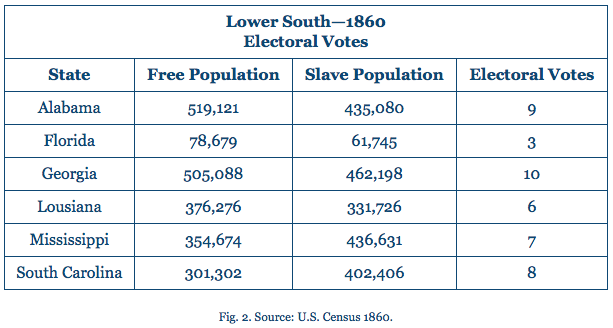
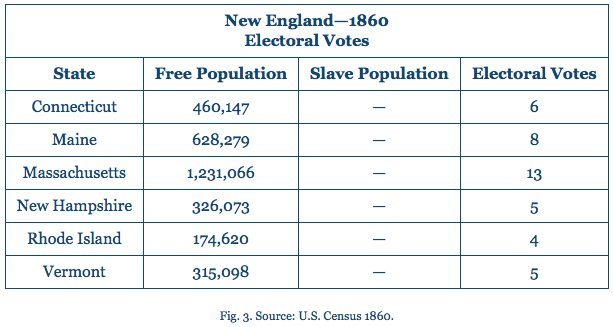
But the South (more accurately the slaveholding autocracy) was fighting a rearguard action that it was likely to lose. As the United States expanded, as new states came into the Union, it became increasingly apparent that the South, notwithstanding its over-weighted representation, would simply be outnumbered. With the exception of Texas, new states, one after the other as they entered the Union, opted to reject slavery. If those trends continued, the end of slavery was likely to be brought about by “death by a thousand cuts.” While a constitutional amendment was still unlikely, former President John Quincy Adams and his Abolitionist successors in Congress were attempting to end slavery in the District of Columbia, to forbid Federal enforcement of the Fugitive Slave Act and to change the rules under which new territories were awarded statehood.
Throughout the antebellum period southerners desperately sought to preserve their way of life. But they watched with increasing alarm as slaves revolted in Haiti, states in the North and in the West refused to return runaway slaves and even Congress considered declaring slavery illegal in the District of Columbia. Plans were floated and expeditions launched to purchase or conquer Cuba for the purpose of converting the island into a slave state. President Franklin Pierce approved the dispatch of a private American expedition (called filibusters) to invade Nicaragua for the purpose of overthrowing that nation’s government with the intent of turning that country into a slave state. Talks were even held with revolutionaries in the Yucatan with the intent of annexation and turning that peninsula into a slave state. But none of these efforts came to fruition and when the Southern aristocracy ran out of options, when a president was elected in 1860 who more or less stated that he opposed slavery, the South pulled out of the Union.2
Even though the South lost the Civil War, the ferocity with which it defended its way of life gave the South leverage for another 100 years. No one wanted to fight the Civil War again. After President Lincoln was assassinated and with the help of President Andrew Johnson, reconstruction was stillborn in the South. While Congress passed and the States ratified the 13th 14th and 15th Amendments, there was no will to actually enforce those amendments. On his own authority, President Andrew Johnson derailed land reform in the South guaranteeing that at least the antebellum social structure would be retained and, then, on Christmas Eve of 1868, on his way out of office, Johnson pardoned all the remaining Confederates held for treason (including Jefferson Davis). Without land reform, with Union troops largely demobilized or withdrawn (or occupied with fighting Indian Wars in the West), the South returned to its antebellum roots in some ways even stronger than before. Now that the slaves were ostensibly free they were counted as full persons for the purposes of apportionment (representation in the House and in the Electoral College) but because they were not allowed to vote, intimidated by groups like the Klu Klux Klan, white Southern property owners were in a very real sense more powerful than they had been before the War.
Between the controversial election of 1876 that ended with a deal that handed the presidency to Republican Rutherford B. Hayes3 in exchange for a final end to the Union occupation of the South and the adoption of the Voting Rights Act in 1965, the South was ruled by the iron hand of Jim Crow.4 With the exception of short bursts of non-racist populism, Huey Long being the prime example, the power structure in the South was based on racist exclusion, Klan intimidation and vote suppression. While we tend to focus on the racial component of discrimination there was also a well-orchestrated class war going on in the South after reconstruction. Poll taxes, literacy tests and property requirements to vote disenfranchised many inhabitants of the South, both black and white. In fig. 4, note the disparity between voter turnout in the North and voter turnout in the states of the former Confederacy.
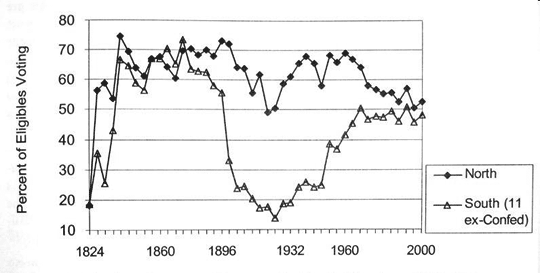 Fig. 4. Voter turnout in the South and in the states of the former confederacy. Source: Vital Statistics on American Politics, 2005–2006, 15.
Fig. 4. Voter turnout in the South and in the states of the former confederacy. Source: Vital Statistics on American Politics, 2005–2006, 15.
Because of the homogeneity of the Southern electorate, reinforced by Jim Crow, Southern politics was relatively stable for almost a century. The South voted as a bloc in national elections and the competitiveness in Southern elections was more a function of personal rather than programmatic rivalries. The Democratic Party dominated in the South; so much so, in fact, that the primary election in most Southern states was in every sense the primary election with the general election of the Democratic nominee being a foregone conclusion in November.5
Republican presidents continued to get elected in the late nineteen and even early twentieth century, without any help from the South. They still represented, after all, the party of reconstruction. Nevertheless, the South still exhibited extraordinary influence in Congress. From the late 19th Century until a set of dramatic reforms were adopted in the House of Representatives in 1975, the House in particular and the Senate as well was dominated by the era of the moss backed turtles (Hinckley; Schickler).6
The moss backed turtles were members of Congress who because they came from relatively stable (electorally) districts served in Congress for long periods of time, often several decades and more and, thus, achieved high levels of seniority. For most of the 20th Century, until the House adopted dramatic rules changes in 1975, committee chairmanships were awarded strictly by seniority.7 Thus, members from the South who represented stable (meaning segregated) districts were exceptionally powerful in Congress throughout most of the 20th century.
But, as always, the South was fighting a rearguard action against the loss of influence. Northern Democrats chafed at having to tolerate the Dixiecrat wing of their party. Outside the South, the politics of the country was dominated by the Republican Party. At the national level the only Democrat who won the presidency between Grover Cleveland and Franklin Roosevelt was Woodrow Wilson and that was because Teddy Roosevelt split the Republican vote in 1912 with his third party, Bull Moose candidacy. As long as the Democratic Party was identified mainly as the party of the rural South, it was unable to muster enough national support to win the presidency. However, the combination of the Great Depression, the political ineptitude of President Herbert Hoover, and the political skills of Franklin Roosevelt combined to hand the Presidency to FDR in 1932. In order to hold the South in the Democratic coalition, Roosevelt as a practical matter did not raise the civil rights issue in exchange for southern support for the policies of the New Deal. It was an alliance that cemented Democratic control of the House until well after the implementation of the Voting Rights Act.8
The New Deal-Dixiecrat alliance in the Democratic Party, however, began to unravel almost immediately after the end of World War II. When President Harry Truman became president, he supported new civil rights legislation and even though he wasn’t able to shepherd that legislation through Congress he did integrate the military and the Federal Government by Executive Order. The Dixiecrats then bolted the Party in the presidential election of 1948. Harry Truman’s surprise victory that year highlighted the weakness of the southerners’ political position. Eisenhower didn’t need the South to win in either one of his campaigns and John F. Kennedy managed to hold the coalition together and win a narrow victory in 1960 by selecting Texan Senator Lyndon Johnson as his running mate. But even in that election it became clear that Dixiecrats were beginning to drift away from the Democratic Party. In 1960, Vice President Nixon won the border states of the South and Tennessee, and third-party candidate Senator Harry Byrd split the rest of the vote with Kennedy in the Deep South.
President Kennedy supported wide ranging Civil Rights legislation but didn’t live to see it passed through Congress. That task was inherited by Lyndon Johnson who took advantage of his landslide electoral win in 1964 to pass through Congress first a Civil Rights Act in 1964 and then in dramatic fashion, a week after civil rights protestors were beaten as they crossed the Edmund Pettis Bridge in Selma, Alabama, the Voting Rights Act of 1965. As Lyndon Johnson signed the bill he turned to his aide Bill Moyers and said, “We’ve lost the South for a generation.” He was wrong; it has been longer than that.
The Voting Rights Act and the South
The Voting Rights Act of 1965 (VRA) does basically three things; for the first time it imposes Federal supervision on national elections; it protects the voting rights of groups designated as a protected class in the meaning the Civil Rights Act; and it subjects certain states and regions of the country to special scrutiny of the Federal Government in regards to changes made to local election laws. Many of these so-called Section Five (of the VRA) are still to this day under supervision to the extent that they must submit proposed changes to their election laws and their redistricting plans to the Federal Justice Department for pre-clearance. In court rulings since, the VRA has been interpreted to mean that not only are section five states required to pre-clear their voting laws but that they are actually required to create “majority minority” districts intended to insure minority representation in Congress.
In general the Voting Rights Act has had both intended and unintended consequences. As of this writing, African American representation in the House of Representatives is fairly close in percentage terms to the population of African Americans in the nation as a whole. In the Senate, however, where there can be no manipulation of district boundaries there are no African Americans serving at all. However, the VRA has been a success to the extent that voting rates among African Americans are now at a level virtually equal to those of other demographic groups. The Voting Rights Act did little to improve the representation of women. Asians, Hispanics or Native Americans, however, have benefitted from the VRA and have been gaining representation at least in the House.
What has been a surprise, however, is what the VRA did the politics of the South and, by association the politics of the United States. The VRA was responsible for a flip in party representation in the South and has further contributed to the extraordinary polarization of party politics that now exists at the national level.
Studies have shown that in counties that with the large expansion in the numbers of black registrants, there was a corresponding and often larger wave of white voter registration. Because there are more whites than blacks, even in the South, the net effect of the VRA act was to make the South more not less conservative. Because while at the same time the VRA resulted in the registration and vote of heretofore disenfranchised blacks, the competitive pressure of increased black turnout mobilized a corresponding white backlash (Carmines and Stimson; Hayes and McKee, 9). These new white voters had also been excluded from voting by the poll tax or had seen no need to vote in the non-competitive electoral environment of the Jim Crow south tended to be poor, conservative and deeply religious.
The consequence of this mobilization counter mobilization effect was to pull the Democratic and Republican Parties ideologically apart. The Democratic Party moved left and the Republican Party moved right. New black voters flocked to the Democratic Party while newly enfranchised white voters joined George Wallace’s American Party and began, tentatively, to vote Republican.
Furthermore, the Supreme Court interpreted the VRA to authorize the creation of “majority minority districts” that were to insure black representation in Congress and in state legislatures (Miller). Conservatives took advantage of this requirement (with the tactic cooperation of minority groups) to create congressional districts that stacked African American voters.9 The net effect of this stacking was to insure greater black representation but, ironically, at the same time to disenfranchise white Democrats who were then scattered into conservative districts where they were perpetually outnumbered. The net effect was to create on average more not less conservative congressional districts, particularly in the South (Ball; Epstein, et.al., 2007).10
Southern whites were still reluctant to vote Republican. The Republican Party after all was the party of Lincoln and of reconstruction and, thus, was anathema in the South. But when in 1968 presidential candidate Richard Nixon adopted his southern strategy, a play for the votes of disaffected whites angered by the Civil Rights and Voting Rights Acts, Republican support in the South began to grow; at first at the presidential level and then later down to the state and local level.
Democratic officeholders in the South then faced a dilemma. They could accommodate their new black constituency by moving to the left or they could jump to the Republican Party. George Wallace moved to the left and in his last run for the Governorship of Alabama did so with significant African American support. Most white Democrats in the South, however, changed parties. Jimmy Carter was the last Democratic Presidential candidate to perform well electorally in the Deep South. In 1980 Ronald Reagan was successful in turning the South into a safe constituency for the Republican Party. While Bill Clinton and even Barack Obama (and a few statewide Democratic office holders) have managed to win isolated statewide elections in the South, the South has become for the Republican Party a sea of red (Black and Black). The Republican sweep of congressional elections in November 2010 has established Republican Control of the South once and for all.
A Sea of Red
What do monochromatic politics mean for the future of the South? If the South is no longer politically competitive, it runs the risk of becoming a political backwater in the context of national politics (Schaller). The Democrats will write off the South as unwinnable, as they did in 2008, and the Republican Party will begin to take the South for granted. Given the conservatism of white southern voters would the Republican Party ever really run the risk of losing the South to the Democrats? Obama did win a couple of southern states, North Carolina and Virginia, but didn’t need them to win the presidential election in the Electoral College.
After 230 years the South has lost its’ leverage. Before the Civil War southerners were overrepresented in Congress by the three fifths rule. After Reconstruction white southerners were overrepresented by the combination of Jim Crow voting policies in the South and the seniority system in Congress. But with the demise of seniority system in Congress and the polarization of American parties, southerners are simply outnumbered. Is Katrina, then, metaphor for the future of Southern politics; low tax, low service states left to their own devices without the resources to not only recover from natural disaster but to supply the normal services of government, roads, police protection, education, and public sanitation?
In the chart below, I present a simple test of the proposition that “the squeaky wheel gets the grease.” Are Federal Resources tied to state electoral competitiveness? Is the South particularly vulnerable to this dynamic?
These charts track Federal payments to the states per capita by year. Note that while grants per capita have been growing overall (it is important to note that these data are not controlled for inflation), southern grants per capita have (for this time period) consistently been less and are falling further behind in recent years. As the chart below shows, in the period since 1992, the difference has increased quite markedly.
But is this difference significant in the statistical sense? Because annual budgets are very much a function of previous year allocations, it is important to control for prior year budgets. That we can accomplish through a (panel control) time series regression which controls for the passage of time while highlighting the other predictor variables that may come into play.
Statistical Analysis
If we use a relatively simple time series model with only two variables, Federal Grants and South/Non-south, we find that during this time period the South gets less Federal grant money than the rest of the country, but not significantly (in the statistical sense) so.11
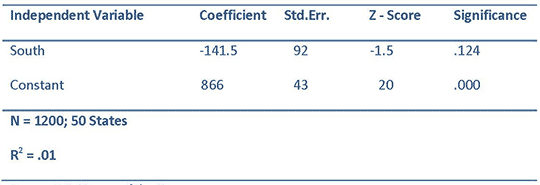 Fig. 7. Dependent Variable = Total Federal Grants per Capita (by State). Source: U.S. Bureau of the Census.
Fig. 7. Dependent Variable = Total Federal Grants per Capita (by State). Source: U.S. Bureau of the Census.But when we control for income of a state, the income variable dominates the equation.
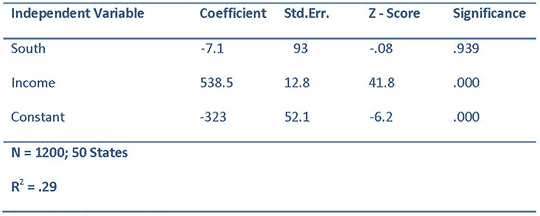 Fig. 8. Dependent Variable = Total Federal Grants per Capita (by State). Source: U.S. Bureau of the Census.
Fig. 8. Dependent Variable = Total Federal Grants per Capita (by State). Source: U.S. Bureau of the Census.What these results tell us is that a major determinant of Federal revenue sharing to the states is the average income of a state. To explain, Federal revenue sharing is money allocated in two ways; through direct grants and through formulas. A large percentage of revenue sharing is formula spending. For example for Medicaid, or health care for the indigent, funding is allocated according to a formula that includes a cost of living adjustment for the recipient state. Consequently, because the South is relatively poor compared to the rest of the country and health care costs are relatively low, the South may receive less in Federal revenue sharing by that standard for that program. However, for other programs that are allocated according to the rate of poverty, the South may benefit. Thus, we need to control for the interaction of South and income; a variable that then becomes a proxy for formula funding. Using that interaction, when we look at Federal revenue sharing with the states we find:
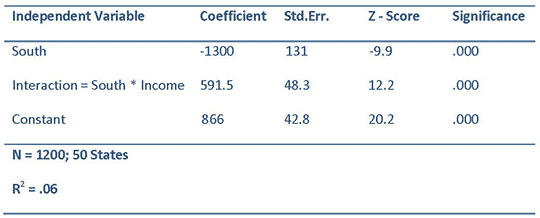 Fig. 9. Dependent Variable = Total Federal Grants per capita (by State). Source: U.S. Bureau of the Census.
Fig. 9. Dependent Variable = Total Federal Grants per capita (by State). Source: U.S. Bureau of the Census.On balance, formula funding favors the South. But for the rest of the federal revenue sharing budget, the discretionary part of the budget, the South has clearly has lost clout.
Federal revenue sharing is only part of explanation for the economic condition of the South. In fact, according to some measures, the South gets more than its fair share of revenue sharing. One widely utilized measure of Federal funding is to compare Federal taxes paid to Federal money coming in. By that standard, the South benefits well indeed. However, this ratio measure of Federal revenue sharing that relies on a comparison of payments to income is as much a reflection of low tax payments as it is of high revenue sharing allocations.12 Since the goal of revenue sharing is not to return tax dollars to the states on a pro rata basis, the South might deserve (in the policy sense) more funding by this standard even still.
Conclusion
For over two hundred years the South has been fighting a rearguard action to protect its way of life. In the 18th and 19th centuries that meant protecting slave based economies and then the legacy of Jim Crow. Built into the Constitution were structural advantages in representation that persisted even after the Civil War. Only after the passage of the Voting Rights Act and changes were made to the seniority system in the House of Representatives did the South lose its structural advantage. To add to that problem is the fact that the South has become basically non-competitive in the partisan sense. That means that the South loses out in the distribution of Federal revenue sharing through benign neglect.
For the South this progression is a good news, bad news story. The bad news is that for consumers of government services in the South; health care, education and housing, they are about to face rather lean times. In what are already low tax, low service states, public services are likely to remain the same or decline without substantial Federal assistance. On the other hand, without much Federal assistance and, thus, much Federal leverage, the governments of the South will be able to exercise their sovereignty to a much greater degree. That represents for the South a victory of sorts. After all, along with the preservation of slavery, state’s rights was a preeminent goal of the South in the War Between the States.13
Works Cited
Ansolabehere, Stephen and James M. Snyder. “Reapportionment and Party Realignment in the American States.” University of Pennsylvania Law Review 153.1 (2004): 433–57.
Ball, Howard. “Racial Vote Dilution: Impact of the Reagan DOJ and the Burger Court on the Voting Rights Act.” Publius 16.4 (1986): 29–48.
Black, Earl, and Merle Black. The Rise of Southern Republicans. 1st ed. Cambridge: Belknap Press of Harvard Univ. Press, 2002.
Black, Merle. “The Transformation of the Southern Democratic Party.” The Journal of Politics 66.4 (2004): 1001–17.
Brace, Kimball, Bernard Grofman and Lisa Handley. “Does Redistricting Aimed to Help Blacks Necessarily Help Republicans?.” The Journal of Politics 49.1 (1987): 169–85.
Bullock, Charles S., Donna R. Hoffman and Ronald Keith Gaddie. “The Consolidation of the White Southern Congressional Vote.” Political Research Quarterly 58.2 (2005): 231–43.
Carmines, Edward G., and James A. Stimson. Issue Evolution: Race and the Transformation of American Politics. Princeton: Princeton University Press, 1989.
Consolidated Federal Funds Report. U.S. Census Bureau. 27 Nov. 2011 <http://www.census.gov/govs/cffr/historical_data.html> .
Epstein, David. 2006. The future of the voting rights act. New York: Russell Sage Foundation, 2006.
Epstein, David et al. “Estimating the Effect of Redistricting on Minority Substantive Representation.” Journal of Law, Economics, and Organization 23.2 (2007): 499–518.
Erikson, Robert S. “The Relationship between Party Control and Civil Rights Legislation in the American States.” The Western Political Quarterly 24.1 (1971): 178–82.
Federal Taxes Paid vs. Federal Spending Received by State, 1981–2005. The Tax Foundation. 18 Oct. 2007. 27 Nov. 2011 <http://www.taxfoundation.org/research/show/22685.html>.
Hayes, Danny, and Seth C. McKee. “Toward a One-Party South?.” American Politics Research 36.1 (2008): 3–32.
Hinckley, Barbara. “Seniority 1975: Old Theories Confront New Facts.” British Journal of Political Science 6.4 (1976): 383–99.
Miller v. Johnson, 515 U.S. 900 Supreme Court of the United States. 1995.
Perry, Rick. Fed Up!: Our Fight to Save America from Washington. New York: Little, Brown and Company, 2010.
Schaller, Thomas F. Whistling Past Dixie: How Democrats Can Win Without the South. New York: Simon & Schuster, 2006.
Schickler, Eric. “Institutional Change in the House of Representatives, 1867-1998: A Test of Partisan and Ideological Power Balance Models.” The American Political Science Review 94.2 (2000): 269–88.
Stanely, Harold W. Vital Statistics on American Politics 2009–2010. 1st ed. Washington, D.C.: CQ Press, 2009.
Wills, Garry. “Negro President”: Jefferson and the Slave Power. Boston: Mariner Books, 2005.
Notes
1 Obama did win in North Carolina and Virginia but he did not need them to gain a majority in the Electoral College.2 Even then, however, it was without the majority consent of its citizens. In the presidential election of 1860 pro-succession candidates failed to win a majority in all but a few states in the Deep South. And because a number of Southern Legislatures refused to approve bills of succession, rump “succession conventions” stacked with pro succession delegates were convened in a number of states to circumvent the regular constitutional process.
3 In fairness to Rutherford B. Hayes who was a former Union General and a stalwart supporter of the goals of Reconstruction, Hayes was probably not involved in the deal that handed him the presidency, but he was perfectly willing to limit himself to one term (due to the controversy surrounding his own election). During that term Hayes restored confidence in the presidency that had been shaken to its core by the corruption of the Grant administration. Furthermore, Hayes spent his term and much of the rest of his life promoting the integration of former slaves into society through education.
4 Jim Crow laws mandated the de jure segregation of whites and blacks in the South.
5 In fact, low turnout in the South is almost always scored as the general election result. But because general elections particularly at the state, congressional and local level were unlikely to be competitive, turnout may have been particularly low in the South because of its partisan homogeneity.
6 Moss back turtle is a reference to the snapping turtle, ubiquitous throughout the South. Snapping turtles as they grow larger tend to sit motionless at the bottom of murky pools waiting for prey to swim past. They sit so still for so long that moss tends to grow on their shells.
7 Seniority is defined as time in continuous service. With a limited and homogeneous constituency, southern districts tended to be the most electorally stable congressional districts in the country.
8 However, southern Democrats did frequently bolt the party to form a conservative coalition of conservative Democrats and Republicans that dominated Congress from about the mid-1970’s until the Republicans regained control of the House in 1994.
9 Stacked districts waste votes by concentrating partisan voters in a district that requires a majority vote to win. Stacking along with cracking are the two techniques used to gerrymander congressional districts and reduce the political impact of one or the other party’s voters.
10 There has been a countervailing trend in other parts of the country, particularly in New England. The conservative tilt of the national Republican Party has forced Republican Party officeholders in New England to make the same choice their Democratic counterparts had to make in the South. Thus, as the South becomes redder, New England becomes bluer.
11 There are 1200 observations in this data set; 50 states for 24 years. Federal revenue sharing data is available from the U.S. Census Bureau, Consolidated Federal Funds Report.
12 For instance, Mississippi receives roughly 2 dollars from the Federal government for every dollar it pays in Federal taxes. But it also pays much less in taxes because it is a relatively poor state. In 2005, Mississippi paid out $12 billion in Federal taxes (and received $26 billion in payments). By contrast Iowa, a state with an equivalent population, paid out $17 billion in Federal taxes.
13 In fact, a number of mainly Southern politicians have begun to suggest that States should actually opt out of Federal Programs such as Medicaid (see Perry).
Author
Suggested Citation

This work is licensed under a Creative Commons Attribution-ShareAlike 3.0 Unported License.


